|
Watch the Iditarod Race Finish in Nome. Our 7-day Iditarod tour program provides the best and up-to-date race action - guaranteed. Just fly to Nome and leave the rest of the logistic to us. We continuously monitor and gather information about the ongoing race to find out were the top mushers currently are. According to the information you'll fly you out to a particular checkpoint with a lot of race action and do not waste your valuable vacation time on a checkpoint with no race activities at all. During the winter of 1925 a diphtheria epidemic raged among Inuit in the Nome area. Fierce territory wide blizzard conditions prevented delivery of a life-saving serum by airplane from Anchorage. A relay of dog teams was organized to deliver the serum. The annual Iditarod commemorates this historic event. |
Iditarod Race to Nome, Native Villages and Checkpoints Tour
Tour Itinerary
Tour Dates / Rates
Iditarod Race FAQ
Anchorage Information
|
Day
01 |
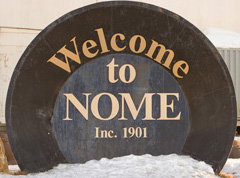 |
Anchorage – Nome (Saturday) Get ready for the Iditarod finish. Transfer to the airport. Morning flight to Nome. Check into your hotel or bed and breakfast in Nome and explore the many sights of the community. Stroll around the city and learn more about the rich history of this gold rush town and the Iditarod Sled Dog Race. Plenty of time to shop for exquisite jade, hand-carved ivory and skin sowings. The nights may provide some outstanding Northern Lights – Aurora Borealis – viewing. Overnight Nome |
|
Day
02 |
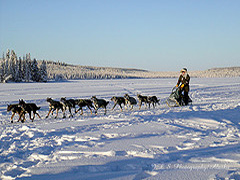 |
Nome - Sightseeing & Area Tour (Sunday) Today it is time to explore Nome and the surrounding area. Get to know the deep knowledge of the area's cultures and history. Seeing Nome on a guided tour is a truly authentic local experience you won't want to miss! Driving around, you'll absorb the historic flavor of this city's 100 years--along with thousands of years of Eskimo history. You'll visit the port, the cemetery, tour through town, and take a drive into the country to take a tundra walk and get a insightful take on the unique ecosystem, then, if you like, try your hand at panning for gold on the beaches of Nome. Overnight: Nome |
|
Day
03 |
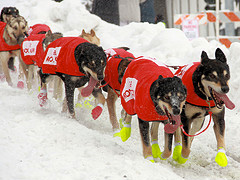 |
Nome - Flight to Unalakleet Checkpoint (Monday) Fly today to Unalakleet Checkpoint (or another checkpoint depending on the race progress). Fly along the Iditarod Trail and spot already sled dog teams from the air. Unalakleet on the shores of Norton Sound is a major logistic hub for the race – about 275 Miles from Nome. Unalakleet is the first checkpoint on the Norton Sound in the famous Iditarod Trail Sled Dog Race. The first musher to reach this checkpoint each year is awarded the title Gold Coast Award, which includes $2,500 in gold nuggets. You have a the afternoon to observe the race activities. By now you are familiar with the checkpoint routine: Mushers come into the checkpoint, mushers leave the checkpoint, vets check dogs, dogs eat, dog feet and muscles are massaged by caring mushers, dogs sleep, mushers sleep and a myriad of other mushing related tasks. Return to Nome in the late afternoon. Overnight: Nome |
|
Day
04 |
 |
Nome (Tuesday) The first musher is expected to arrive today. The last stretch of the trail is exposed to the elements and ground blizzards are not uncommon. Gather near the "Burled Arches" along Front street to watch the spectacle as mushers approaches the finishing line with his dog team - greeted by a cheering crowd, TV Stations, Film Crews and newspaper reporter. Throughout the day cheer the mushers as they are crossing the finish line in Nome. You have time to participant in the many activities Nome has to offer during the Iditarod Race: the Bering Sea Ice Golf Classic, Helicopter Tour, visit the Native Craft Fair or the Idita-Mardi Gras Party. Overnight: Nome |
|
Day
05 |
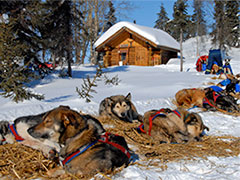 |
Nome - Flight to Koyuk or White Mountain Checkpoint (Wednesday) Morning flight from Nome to Koyuk on the shores of Norton Bay or to White Mountain (depending on the race progress). Koyuk checkpoint is only 171 Miles from Nome. Mushers are usually dealing with bad weather conditions along this stretch. High winds and temperatures of 40-below are common. The way to Shaktoolik is also extremely difficult to run due to the ever-present threat of open water and moving ice. This is certainly one of the hardest stretches of the race. White Mountain Checkpoint is located just 77 miles from Nome, on the banks of the Fish River. It takes its name from that of a picturesque nearby mountain. The checkpoint is located in the community hall building up the hill from the store. White Mountain is most notable as the last of three mandatory rest stops for teams competing in the annual Iditarod. All mushers are required to take an 8-hour rest stop at White Mountain before making the final push to the end of the race, 99 miles away in Nome. Spend the afternoon to observe mushing activities. Return Flight to Nome. Overnight: Nome |
|
Day
06 |
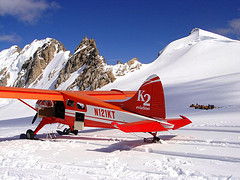 |
Nome - Snowcat Tour to Safety (Thursday) This morning watch more and more mushers arriving in Nome. This afternoon enjoy the snowcat ride to Safety. Travel across the snow covered frozen tundra to view wildlife and gold rush landmarks across a beautiful and wild land. Muskox sightings on this trip are very common! It is amazing to see what it must be like to be out so far from anything like the mushers are. This is their last stretch before they arrive in Nome, and you might have passed a couple mushers. Safety Checkpoint is a warm and welcoming place. Joe runs the place and welcomes everyone with a story. Visitors from near and far visit the Roadhouse and leave a dollar bill with their name on it stapled to one of the walls. Overnight: Nome. |
|
Day
07 |
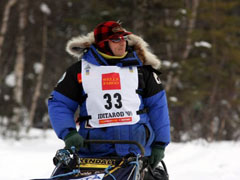 |
Nome - Anchorage (Friday) Morning on your own. Return flight from Nome to Anchorage during the day. We have several flight times available. Optional tour extension or additional nights in Nome on request. |
| Rates in US $ | per Person | Single | Double | Triple | Quad |
| ✦ Iditarod Race to Nome ✦ | $ 4180.00 | $ 3460.00 | $ 3260.00 | $ 3180.00 |
|
 |
Iditarod General InformationThe HistoryFor six thousand years, sled dogs have served as the principal form of transportation for the native peoples of the north. As white settlers, gold miners, and fur trappers moved into what is today Alaska and the northern territories of Canada, they, too, used the dog team for winter transportation. When gold camps boomed in the interior the demand for mail and general supplies deliveries during the winter months were provided by sled dog teams. One of the major routes followed by the teams was the Iditarod Trail, which crossed Alaska from Seward on the Kenai Peninsula to Nome on the Bering Sea Coast. In the winter of 1925, a diphtheria epidemic struck Nome. The anti-serum required to stop the epidemic needed to be quickly transported to Nome, but no roads to Nome existed, ships could not sail through the pack ice, and air travel was too dangerous. The Iditarod Trail was the only answer, and a group of 18 dog teams and musher’s relayed the serum 674 miles from Nenana to Nome. This is the well-known story of Balto – the lead dog of the initial serum race. Clearly sled dogs were a key part of Alaska's early history, but they began to disappear as snowmobiles, airplanes, and roads arrived in Alaska during the middle 20th century. In response to this disappearance, Joe Redington Sr. and a group of musher worked together to start a race across Alaska that followed the old Iditarod Trail. This race was the Iditarod Trail Sled Dog Race, and it has become the world's premiere sled dog race since its first running in 1973. |
The 2 Different Iditarod TrailsYes, but only the middle part – approximately 300 miles of the trail alternates. The Northern Route, used in even-numbered years, heads north from the checkpoint to Ophir, reaches the Yukon River at Ruby, and travels downriver to Kaltag. The Southern Route, used during odd-numbered years, heads south from Ophir, passes through the ghost town of Iditarod, and reaches the Yukon River just below the checkpoint at Anvik. The trail then heads upriver to Kaltag. From Kaltag the trail is the same every year to the finish, and the trail from the starting line to Ophir is also the same each year. Please refer also the Iditarod Trail Map below. |
Participating MusherAbout 40-90 musher’s are usually participating. The largest number of musher ever to start the Iditarod was in the 2000 race when 82 musher left the starting line. The most to ever finish was in 2004 when 77 musher successfully made it to Nome. No limit has been imposed on the number of entries, but talks have been made of limiting the number to 100 teams if needed at some point in the future. A qualified musher is a person who is at least 18 years of age, is in good standing with the Iditarod Trail Committee, and has met one of the two following requirements: successfully finished a previous Iditarod or successfully finished two approved qualifying races totaling 500 miles or more in the 24 months prior to the start of the Iditarod the musher wishes to enter. Women have raced in every Iditarod since 1974, and currently about a dozen women run the race every year. Two women have won the race. Libby Riddles was the first woman to win the race when she braved her way through a storm in the 1985 Iditarod. Susan Butcher has won four Iditarod’s in the years 1986, 1987, 1988, and 1990. Because of Libby Riddles and Susan Butcher hold on the winner's circle from 1985 to 1988, the Iditarod Trail Committee trademarked the phrase: - "Alaska: Where men are men and women win the Iditarod."The Iditarod Champion receives about 50,000 dollars in cash plus a brand new Dodge Ram 4x4 pickup (Alaska’s Dodge Dealers are a major race sponsor). A total of about 500,000 dollars is distributed to the top 30 finishers in the race each year, and every musher who finishes the race is awarded $1,049. A few other smaller prizes are awarded along the trail to the first musher into the checkpoints of McGrath and Unalakleet, as well as the first musher to the halfway point and the Yukon River. Other race awards include the Sportsmanship Award, the Humanitarian Award (for the musher who demonstrated the best dog care) the - Rookie of the Year Award - the most Inspirational Musher Award, and the Red Lantern Award (for the last place musher). |
The Checkpoints | Checkpoint Fly-outsThe race trail has a total of 26 checkpoints between the starting line in Willow and and the finishing line in Nome. The checkpoints vary from people's homes along rivers to old cabins in the woods to villages and ghost towns. A few checkpoints are just remote place where planes could land to drop off officials and food and set up tents. The checkpoints are sort of the activity centers for the race. All of the veterinarians, officials, and food for musher and dogs are at the checkpoints. When a team arrives at a checkpoint, a checker signs the team into the checkpoint and records the time, date, and number of dogs in the team. Checkers also point out the location of camping sites for the team, the food drop bags (if a food drop checkpoint), and water (if available). Teams are not required to rest at every checkpoint, however, so sometimes teams just pass through and head out on the trail again whereas other teams stop for a rest. The Iditarod rules require a total of three rest stops. The first rest stop is a 24-hour stop that must be taken at a checkpoint of the musher's choice along the trail. This rest is typically taken between 300 and 600 miles into the race. The second rest stop is an eight-hour stop that must be taken at a checkpoint along the Yukon River. The third and final required rest stop is an eight-hour stop at the village of White Mountain, 77 miles from the finish line in Nome.We mainly use reliable Cessna 202/204/206 or deHaviland Beaver for the flights from Anchorage to the checkpoints at Rainy Pass Lodge and Nikolai. Customers who travel to Nome could visit the following additional checkpoints: Safety, White Mountain, Golovin, Elim, Koyuk, Unanakleet and Shaktoolik. Please refer to each particular Iditarod tour program. |
The TrailThe Iditarod Trail Breakers are some of the most hard-core snowmobile driver in the world. They make a 1,100-mile "highway" across Alaska every winter. About 10,000 pieces of surveyor's stakes with orange paint and reflective tape are used to mark the trail. Additional ribbons and tripod markers are used in places like the Alaska Mountain Range and the Bering Sea Coast. The rules require musher to stay on the marked race trail. Despite such a heroic marking effort, winds, passing dogs and snowmobiles, and even wild animals can knock down markers. Musher still must know how to find and search the snow for signs of other dog teams. |
The DogsThe most commonly used dog in the Iditarod is the Alaskan Husky. The Alaskan Husky is actually a mixed breed, or mutt, dog that is born and bred to love to pull. Alaskan Huskies are a descendent of the original northern sled dogs (mostly domesticated wolves and wild dogs) used by the native peoples of the North Country. Beginning 150 years ago, white settlers, gold miners, and fur trappers moved into thee northland and brought their own dogs with them. These dogs were a hodge-podge mix of larger breed dogs from the Lower 48 and other parts of the world that were not raised and bred for pulling. As a result, these dogs didn't do very well, but as these dogs interbred with the native sled dogs, the resulting dogs were excellent sled dogs, and the original "mutt" Alaskan Husky was born. The mixing of the breeds provided a great deal of genetic diversity and hybrid vigor that is still found in these dogs today. Over the last 100 years, musher’s have mixed in other breeds in order to obtain dogs best suited to various uses. Some of these breeds include hounds, pointers, collies, and even some German Shepherds, Siberian Huskies and Alaskan Malamutes are purebred derivatives of the original sled dogs, and can be considered cousins to the Alaskan Husky. Some musher’s use these breeds, but these breeds lack the stamina, endurance, and attitude of the Alaskans |
Ceremonial Start in Anchorage | Restart in WillowThe race begins always on the first Saturday in March on 4th Avenue in downtown Anchorage. However, the first race day is just a ceremonial start, and teams run only from Anchorage to Eagle River, 25 miles away. The time from the starting day has no effect on the final outcome of the race. This ceremonial start is done in order to allow for better publicity and coverage for the musher and the race, and it also allows each musher to give one lucky "Idita-Rider" a ride in his or her sled at the starting line. On the following day, the race is re-started in Willow, about 50 miles from Anchorage. This is the official timed start of the race. The reason for moving the teams out of Anchorage for the restart is that the congestion of Anchorage streets coupled with the geographic barrier of the Knik River and Knik Arm of Cook Inlet (part of the Pacific Ocean) make it safest to start in Willow. |
The Mushers BanquetThe Mushers Banquet is held every year on a Thursday - e.g. two days before the race start - at the newly build Dena’ina Center in downtown Anchorage. This is your chance to get up close and personal, talk to the musher, take pictures and collect autographs. A dinner is included in the ticket price. During the banquet musher’s usually thank their sponsors and draw starting numbers from a boot. The order in which musher’s pick numbers from the boot is determined by the order in which musher signed up for the race. This banquet draws yearly a crowd of nearly 2000 spectators into the center. The doors are opening around 4:00 pm and the dinner begin at 6:00 pm. Our tours include admission and the dinner. Please note: We do not provide a ticket service for individual customers without a tour package ! |
Weather ConditionsThe weather is always an unknown variable. From November to early March, when the amount of daylight ranges from 10 to less than 4 hours per day, the lowest temperature readings will fall below zero. Low temperatures of -40 to -50°F or colder occur each winter. Long periods of five to ten or more days of extremely low temperatures occur during the winter months. Nome is the exception, with Norton Sound moderating the local temperatures. While Nome’s overnight winter temperatures typically fall to near zero, readings lower than -20°F are uncommon. From October through April, snow cover is persistent in most areas, without interruption. Colder weather is easier on the dogs, which generally run best in a range from 20-below zero to 20 degrees above. The coldest temperature ever recorded on the Iditarod Race was in ’73 when the temperature with wind chill plummeted to unbelievable –130º F. |
Customized Iditarod Tours | Reservation CenterWe can certainly customize any of our tours for you but it is important to contact us as early as possible because overnight accommodation along the trail is very limited. The same applies to fly-outs from Anchorage to the checkpoints or programs with finishing in Nome. We advertise a “custom program” with a variety of checkpoint fly-out options, program extensions and choice of hotel accommodation. Please contact us for additional information. Note: always reserve tours as soon as possible because most Iditarod Packages are providing only a very limited capacity due to the wilderness lodge accommodation and/or the checkpoint flights. Sometimes tours are booked one year in advance but during some other years you may be lucky to obtain individual space up to two months before a tour starts - but in general this is very unpredictable. |
ClothingWe recommend to pack the following clothing: warm winter boots such as "Sorels", shell lining such as Gore Tex or other winter (ski) jackets, windbreaker, wool or fleece pullover, long underwear, gloves, hut, sunglasses, wool socks, wool shirts, jeans, fleece pants. Also take some additional food, fruits and drinks for the days in the wilderness with you. Most stores in Anchorage are carrying a wide variety of healthy outdoor food items. The luggage during fly-outs is limited to smaller soft shell cases or backpacks. Please do not use hard shell luggage on fly-out days. |
General Accommodation InformationSuperior Hotels: Located in downtown Anchorage. Hotel amenities include: free local calls, 24-h fitness center access, laundry, high speed DSL and wireless internet access and business center. The rooms (non-smoking) are providing a private bathroom, cable TV with pay per view channels access, coffee maker, refrigerator, iron - and ironing board, phone with voice mail, data port. The ceremonial starting line of the Iditarod race, many stores and department stores are within a 10-15 minute walk. The hotel is about 15 minutes from Ted Stevens International Airport.First-Class Hotels: Upgrade to the Hilton, Marriott or Westmark - all centrally located within downtown Anchorage with sweeping views of Ship Creek, the Chugach Mountains and/or the Cook Inlet. Hotel amenities included: fitness center, indoor pool, steam rooms, restaurants, bars, coffee shop, high speed internet access, business center. All deluxe rooms (non-smoking) are providing a private bathroom, luxurious bathroom amenities, flat screen TV, phone, deluxe mattress, down comforter, king/queen beds, alarm radio, MP3 Player plug in, hair dryer, iron- and ironing board, dual coffee maker. Restaurants and shopping areas are in walking distance from the hotel. Transfer time from the Ted Stevens Int'l Airport to the hotels is approximately 20 minutes (not included). |
|
|

Anchorage Winter Activities
The crystal gallery of ice carving competition kicks off the winter festivities in Anchorage each year. It marks the beginning of many activities to come between January and April - such as the Iditarod and the Iron Dog. The ice carving competition occurs around the first weekend of January and happens in Anchorage’s town square with teams traveling as far as China to compete. Teams are provided with two blocks of ice weighing around 3 to 4 thousand pounds apiece and 48 hours to turn the blocks of ice into a masterpiece. Be careful when going to view the ice sculptures as they are located on an ice rink, literally. Or better yet bring your ice skates along for the adventure. Ice skating is free.
Fur Rendezvouz Activities
Inuit Blanket Toss
The blanket toss competition is like jumping on a trampoline, except the people who are holding the blanket are raising and lowering it to toss a person. This is the game often played at festivals and other Inuit celebrations. The "blankets" for the game are usually made from seal and walrus skins, so it can handle the pounding that results every time a player lands on it after the "toss." The winner is the player who bounces the highest. This game started when mountain men, Inuits and old fur traders used to meet in a pre-arranged place in the early spring each year to trade their winter's kills (furs) for cash and supplies. In the early 1900s, these meetings stopped happening because modern trappers and fur buyers had no use for them. But in the 1930's, a group of people who wanted to preserve their history brought back these meetings in the form of a 10-day celebration where games like the Blanket Toss are played.
Native Arts Market
Featuring over 150 Native Artisans selling and demonstrating their art - from basket weaving, dolls, beading, carving and more! A rare opportunity to meet and greet the artists and watch them create their one of a kind items. The Charlotte Jensen Native Arts Market is named for Charlotte Jensen as a tribute to her many years of service and her love of all things Rondy. She was a Past President, Former Lady Trapper, Vern Johnson Award winner, and long-time Board member of Greater Anchorage Inc. since the 1970’s. Charlotte was also Chairperson of the Merchandise Committee and the Native Arts Market.
Miners and Trappers Charity Ball
Break out the costumes and celebrate the 62nd Anniversary of the Miner’s and Trapper’s Charity Ball. Bring your world class beard and extremely tolerant other half to compete in the “Mr. Fur Face Contest,” the Alaska State Championship Beard and Mustache Contest. The Miner’s and Trapper’s Charity Ball has raised several million dollars for local charities and is produced by area Lions Clubs. The Egan Center - Tickets: $30.00 per person
Alaska Trappers Association Fur Auction
The South Central Chapter of the Alaska Trappers Association brings you the finest in Alaskan Fur, continuing its legacy as one of the original events of Rondy.
World Championship Sled Dog Races
With a great big field of amazing mushers from Alaska, Germany, Canada and the lower 48. Sled Dog Races are a Fur Rendezvous classic which began in 1946 and continue today with what is known as "The Rondy." The Open World Championship Sled Dog Race is considered the grandfather of all Alaskan races! The Rondy is produced by the Alaskan Sled Dog Racing Association (ASDRA). Come and witness the sheer intensity and excitement that is the most anticipated sprint race in North America. Endurance, Speed, and agility prove these dogs to be true athletes.
Iditarod View Points in Anchorage
Iditarod fans have an array of spots where they can watch the 62 race teams make their way across Anchorage on Saturday morning. One of the best is at the end, on Campbell Tract in Far North Bicentennial Park. There's parking at the "BLM" Bureau of Land Management Science Center, 5600 Science Center Drive off Elmore Road, for about 500 vehicles as well as shuttle buses to Kasuum Elementary (about 100 spots) and Abbott Loop Community Park (75 spots). After parking, spectators can follow wooded winter trails to viewing areas or use a shuttle to sample different viewing areas. School buses will run a loop route between 10:00 h and 16:00 h With the ceremonial start beginning at 10:00 h downtown, you'll have plenty of time to get a taxi from downtown Anchorage to the viewing areas before dog teams start arriving at around 11:00 h. The BLM staff put a lot of effort into preparing the terminus site to accommodate free public parking and close-up sled dog viewing and the Campbell Tract venue is one of our best kept scenic secrets to watch the musher away from the crowd. Portable toilets will supplement restrooms at the Campbell Creek Science Center, 5600 Science Center Driver off Elmore Road. The center also has hot chocolate and Iditarod exhibits.
Outdoor Activities in Anchorage
Nordic Skiing is available at Kincaid Park, on the Coastal Trail, Beach Lake, Eagle River and along the Hillside.
